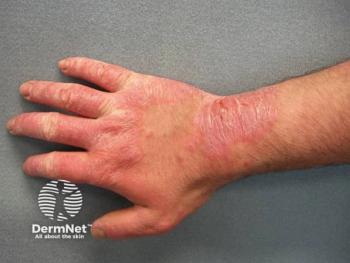
- Dermatology Times, July 2025 (Vol. 46. No. 07)
- Volume 46
- Issue 07
Beyond Efficacy: Why We Need a New Look at Drug Safety
Key Takeaways
- Safety analysis lacks a universal endpoint, complicating the interpretation of adverse events compared to efficacy analysis.
- Traditional safety data reporting can be misleading; EAIRs offer a more accurate risk assessment by considering drug exposure duration.
Matthew Zirwas, MD, discusses the complexities of safety analysis in psoriasis clinical trials, advocating for exposure-adjusted incidence rates to enhance risk communication.
Safety analysis in clinical trials, particularly for conditions such as psoriasis, presents a unique set of challenges compared with efficacy analysis. Although efficacy trials typically have clear, predefined end points, safeness lacks such a singular metric. This often leads to safety data being presented as a collection of common or treatment-related adverse events, leaving clinicians to grapple with interpretation and the identification of true safety signals.1
In a recent interview with Dermatology Times, Matthew Zirwas, MD, a dermatologist at Bexley Dermatology in Bexley, Ohio, who has a keen interest in clinical trial methodology, shed light on the complexities of interpreting safety data and offered practical guidance for clinicians and researchers alike. His insights, based on recently published research, underscore the need for a more standardized and meaningful approach to reporting adverse events and emphasize the critical role of exposure-adjusted incidence rates.2
The Elusive Nature of Safety Data
According to Zirwas, the primary difficulty in assessing safety lies in the absence of a universal “safeness” end point. Unlike efficacy, for which a specific measurable outcome (eg, Psoriasis Area and Severity Index score) can be tracked, safety encompasses a broad spectrum of potential adverse events. This makes it challenging to discern whether an observed event is a random occurrence or a genuine safety signal associated with the treatment.
Furthermore, traditional methods of reporting safety data, such as the percentage of patients experiencing an adverse event, can be misleading. Zirwas explained that the denominator in such calculations can significantly impact the perceived frequency of an event. For instance, including patients who dropped out early after a single dose might dilute the true incidence, whereas focusing only on patients who completed a full study duration could exclude those who experienced an adverse event and subsequently withdrew.
The Power of Exposure-Adjusted Incidence Rates
To overcome these limitations, Zirwas advocates for the widespread adoption of the exposure-adjusted incidence rate (EAIR) as the standard for reporting adverse events, particularly those of clinical significance. The EAIR, often expressed as events per 100 patient-years of exposure, provides a more accurate and comprehensive picture of risk.
“You can think of that as meaning if 100 people were on the drug for 1 year, how many people would you expect this to happen to,” Zirwas explained. This metric effectively accounts for varying durations of drug exposure among participants, allowing for a more robust comparison of safety profiles. For a clinician, presenting this number to a patient—for example, “If you’re on this for a year, there’s a 1 in 400 chance that this will happen to you”—offers a tangible and understandable risk assessment.
Navigating Black Box Warnings and Patient Communication
The presence of black box warnings on medications, although crucial for highlighting serious risks, can inadvertently induce fear and uncertainty in patients. Zirwas emphasized the importance of contextualizing these warnings during patient discussions, focusing on the comparative risk rather than absolute numbers.
His preferred approach involves comparing the EAIR of a particular adverse event in patients on the drug with the expected incidence rate of that event in individuals with the same condition who are not on the drug. For instance, when discussing major adverse cardiovascular events or venous thromboembolic events with a patient taking a JAK inhibitor, he might explain that although a warning exists, “the data have shown that for people with your condition who were on this drug, they are no more likely to have it happen than people who are not on the drug.”
This nuanced approach helps mitigate patient anxiety by reframing the risk within the context of the disease and general population data. For adverse events where an increased risk is genuinely observed, such as herpes zoster with JAK inhibitors, Zirwas said he directly communicates this, stating, “Yes, there’s a risk. The data have shown there’s an increased risk of getting herpes zoster.” He said he avoids overwhelming patients with complex numerical data, opting instead for a clear and concise summary of the comparative risk.
The Imperfect Pursuit of Perfect Safety Data
Zirwas acknowledged that obtaining ideal safety data is an ongoing challenge. The perfect scenario—a long-term, placebo-controlled trial—is practically unattainable because patients are unlikely to remain on a placebo for extended periods.
Zirwas explained that this necessitates reliance on different types of studies, each with its own limitations:
- Short-term placebo-controlled trials:
These provide a direct comparison with placebo but are often too short to capture uncommon or delayed adverse events. - Long-term safety studies:
Although these studies offer extended observation periods, they often lack a placebo arm, making it difficult to definitively attribute events to the drug versus the underlying disease or other factors. This often requires comparing observed rates with expected rates from real-world data in similar patients. - Comparative long-term trials:
When drugs are compared with other active treatments (eg, tofacitinib vs adalimumab), the safety findings are relative to the comparator drug, not to a state of no treatment. This can lead to misinterpretations, as a drug might appear to have an increased risk compared with a comparator that actually protects against certain events.
Despite these complexities, Zirwas maintains that the EAIR, when compared with the expected rate for the target population, provides the most comprehensive and actionable information for understanding drug safety.
A Call for Future Directions
Zirwas advocates for a shift in how safety data are collected and presented in clinical trials. He said he hopes to see EAIRs become the standard reporting metric for all clinically relevant adverse events in phase 3 manuscripts and pharmaceutical company materials. This standardization would equip clinicians with more meaningful data, enabling them to make informed decisions and communicate risks more effectively to their patients. By focusing on EAIRs and contextualizing risk within the broader patient population, the medical community can move toward a more transparent and interpretable approach to drug safety.
References
- Drakos A, Vender R. A review of the clinical trial landscape in psoriasis: an update for clinicians. Dermatol Ther (Heidelb). 2022;12(12):2715-2730. doi:10.1007/s13555-022-00840-9
- Zirwas M, Trickett C, Gorelick J, et al. Interpreting safety analyses in psoriasis clinical trials. J Clin Aesthet Dermatol. 2025;18(3-4, suppl 1):S16-S23.
Articles in this issue
5 months ago
Dermatology Times July 2025 Print Recap5 months ago
Is AI Transforming Skin Care?5 months ago
The Value of RAD, According to Clinicians5 months ago
A New Canvas for Conversations in DermatologyNewsletter
Like what you’re reading? Subscribe to Dermatology Times for weekly updates on therapies, innovations, and real-world practice tips.



















